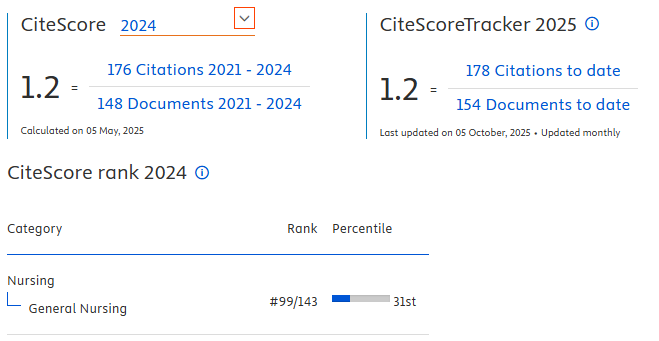The Influence of Impedance and Enhancement Factors of Discharge Planning Implementation at Hospital: A Systematic Review
Downloads
Introduction:Discharge Planning is one of various nursing duty agendas, starting from when patients are admitted to hospital up to being allowed to go home. The phenomenon of implementation discharge planning for patients today is not optimal whereby nurses just do limited implementation of routine activities in the form of information on re-control. Based on those facts, the author wishes to study the analysis of impedance and enhancement factors in discharge planning implementation at hospitals.
Methods: The researcher conducted investigation in February 2020 and involved exploration of some scientific papers journal from ScienceDirect, ProQuest, Scopus, and, PubMed as references with keywords nursing discharge planning, enhancement and impedance factors, implementation, and, hospital. This paper identified15 relevant research articles from 500 original full texts between 2010 and 2018 and analyzed inclusion criterion of enhancement and impedance factors in discharge planning implementation. It involves three RCTs, eight descriptive, and four qualitative research papers
Results: As a result, there are found eight enhancement and five impedance factors influencing in discharge planning implementation. Meanwhile, from 3250 research respondents, 2125 persons reports enhanced factors contrary 1.125 samples imply impedance factors.
Conclusion: The implementation discharge planning is influenced by some factors that should be given attention by nurses to do discharge planning properly.Abdulrdha, & Mansour. (2018). Effectiveness of an instructional program on nurse's knowledge and practice concerning patients discharge planning post cardiac surgery at cardiac centers and hospitals inbaghdad city. Journal of Nursing Management, 26, 707–716.
Backer, T. E., Howard, í†. E. A., & Moran, í†. G. E. (2007). The Role of Effective Discharge Planning in Preventing Homelessness. Journal Primary Prevent, 28, 229–243. https://doi.org/10.1007/s10935-007-0095-7
Collins, D. (2017). Assessing the effectiveness of advanced nurse practitioners undertaking home visits in an out of hours urgent primary care service in England. Journal of Nursing Management, 25, 519–530.
Durocher, E., Gibson, B. E., & Rappolt, S. (2016). Mediators of marginalisation in discharge planning with older adults. Cambridge University Press.
Fitzgerald, L. R., Nurs, D. T., & Lecturer, S. (2011). Hospital discharge : recommendations for performance improvement for family carers of people with dementia. Australian Health Review, 364–370.
Gray, Constance; Christensen, Martin; Bakon, S. (2016). Nurse initiated and criteria led discharge from hospital for children and young people. Nursing Children and Young People, 28(8). https://doi.org/10.7748/ncyp.2016.e714
Kaya, S., & SainGuven, G. (2018). Patients' readiness for discharge: Predictors and effects on unplanned readmissions, emergency department visits and death. Journal of Nursing Management.
Mohamed, S., Parker, S., & Arbon, P. (2014). A survey of Malaysian Critical Intensive Care unit nurses 'awareness of patients' transition experiences (PE) and transitional care practice (TCP). Intensive & Critical Care Nursing, 30(4), 196–203. https://doi.org/10.1016/j.iccn.2013.12.006
Nursalam. (2018). Manajemen Keperawatan aplikasi dalam praktik keperawatan profesional (5th ed.). Salemba Medika.
Pauline Voie , Mona; Tunby , Jorunn; Strí¸msvik, N. (2018). Collaboration challenges faced by nurses when premature infants are discharged. Nursing Children and Young People, 3(2). https://doi.org/10.7748/ncyp.2018.e960
Roberts, S., & Moore, L. (2018). Improving discharge planning using the re-engineered discharge programme. Journal of Nursing Management.
Rudd, Caroline; Smith, J. (2013). Discharge planning. Nursing Standard, 17.
Watts, R., Gardner, H., & Pierson, J. (2005). Factors that enhance or impede critical care nurses ' discharge planning practices. Intensive and Critical Care Nursing, 21, 302–313. https://doi.org/10.1016/j.iccn.2005.01.005
Watts, R. J., Pierson, J., & Gardner, H. (2005). How do critical care nurses define the discharge planning process ? Intensive and Critical Care Nursing, 21, 39–46. https://doi.org/10.1016/j.iccn.2004.07.006
Wong, E. L. Y., Yam, C. H. K., Cheung, A. W. L., Leung, M. C. M., Chan, F. W. K., & Wong, F. Y. Y. (2011). Barriers to effective discharge planning : a qualitative study investigating the perspectives of frontline healthcare professionals. BMC Health Services Research, 11(1), 242. https://doi.org/10.1186/1472-6963-11-242
Yam, C. H. K., Wong, E. L. Y., Cheung, A. W. L., Chan, F. W. K., Wong, F. Y. Y., & Yeoh, E. (2012). Framework and components for effective discharge planning system : a delphi methodology. BMC Health Services Research, 12(1), 1. https://doi.org/10.1186/1472-6963-12-396
Yilmaz, M. C., & Ozsoy, S. A. (2010). Effectiveness of a discharge-planning program and home visits for meeting the physical care needs of children with cancer. Springer, 243–253. https://doi.org/10.1007/s00520-009-0650-2
Authors who publish with Jurnal Ners agree to the following terms:
- Authors transfer the Copyright and grant Jurnal Ners the right of first publication with the work simultaneously licensed under a Creative Commons Attribution 4.0 International License that allows others to remix, adapt and build upon the work with an acknowledgment of the work's authorship and of the initial publication in Jurnal Ners.
- Authors are permitted to copy and redistribute the journal's published version of the work (e.g., post it to an institutional repository or publish it in a book), with an acknowledgment of its initial publication in Jurnal Ners.
Jurnal Ners requires a formal written declaration and transfer of copyright from the author(s) for each article published. We, therefore, ask you to complete and return this form, retaining a copy for your own records. Your cooperation is essential and appreciated. Any delay will result in a delay in publication. The form can be downloaded HERE.
































